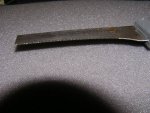It is going to work very good from 3xAAA. It would even work from 2xAAA, but not that long. Dr_Lava's driver is an amazingly good driver!
You can not measure the mW coming out of the driver. You can only measure the mA coming out.
A dummy load would be a good idea. You could use 5 1N4007 diodes as a dummy load and measure the current in series. This means you have to chose a high enough current measuring range on your DMM (higher than the highest current coming from the driver) and then pass this current through the DMM and into the dummy load. (On most DMMs you have to plug the red probe into a different socket.)
The DMM will then show the current, and when you turn the pot, this current will change. You will probably want to set the current to 90mA or less.
When the current is set, you have to connect just the dummy load to the driver alone, without the DMM in between. Then use the voltage measuring range of the DMM to measure the voltage across the dummy load. If the voltage across the dummy load is higher than 2.4V you are good to go. If the voltage should be lower, the driver will not be working properly, and the current will not be set correctly. If it is at least 2.5V or more, it is good.
You can disconnect the dummy load from the driver, short the driver output for a few seconds (to discharge any capacitors) and then you can solder your diode to the driver.
And then you are done. The current will be the same as it was through the dummy load, even if the voltage will be different.
Another, faster possibility is to first set the pot to the lowest possible current setting, solder the diode directly to the driver, but put a 1 Ohm 1% resistor in between.
Then you turn it on, and measure the voltage drop across the 1 Ohm resistor. The voltage drop ACROSS a 1 Ohm resistor in mV is the same as the current THROUGH the resistor in mA.
Then you slowly turn the pot until you reach the desired current. If you want 90mA, you have to turn the pot carefully and slowly, untill you measure 90mV voltage drop across the 1 Ohm resistor.
In this case your laser is now already working. You can then remove the resistor, short the output for a few seconds just in case, and solder the diode directly. Or you can leave the resistor in, in case you ever want to adjust the current again. The 1 Ohm resistor will not influence the operation of the driver in any way. The battery life would be a little bit shorter, but you wouldn't even notice this.
What you should NOT do under any circumstances is power up the driver without a load. You also shouldn't make temporary connections between your laser diode and the driver. It should be soldered there permanently. Otherwise, if it disconnects temporarily and reconnects again while the power is on, the driver can kill your diode (by charging a capacitor to a high voltage) or the driver can even kill itself if powered up without a load.
Most of this is in the instructions you will get with your driver btw...




